The Western, on film, has dwindled in prevalence and fashionability since its mid 20th century heyday. Has the cowboy rode off into the sunset, never to be seen again?
Nah.
Like any other genre and art form, the Western has expanded, grown, and metamorphosed. Instead of just the classic shoot ’em up westerns, or simple tales of morality and justice, westerns throughout the 20th century and into the 21st have become more fluid and flexible, as seen in the more revisionist, Spaghetti Westerns of the 1960s and ’70s, and the challenging of the noble hero, and daring to impart ambiguous endings.
Since we have covered some of the classics in the genre, we now explore the new frontier for the Western, and a few of the directions these films have taken since the 1970s.
The Throwbacks and Remakes:
 These films pay homage to the old school Western–they are set in the wild west, and they employ themes prevalent in the genre (the hero or anti-hero tale, interactions with native americans, etc), but not necessarily with the same outcomes. In Dances With Wolves, the rules and conventions are played to the letter–noble, solitary hero goes out west and discovers the new frontier, both external and internal, as he fights to protect the innocent. Clint Eastwood’s Unforgiven, on the exact opposite end, turns convention on its head by creating a tale without morality, and a solid anti-hero in old gunslinger Munny. An extremely risky move, but ultimately with positive results.
These films pay homage to the old school Western–they are set in the wild west, and they employ themes prevalent in the genre (the hero or anti-hero tale, interactions with native americans, etc), but not necessarily with the same outcomes. In Dances With Wolves, the rules and conventions are played to the letter–noble, solitary hero goes out west and discovers the new frontier, both external and internal, as he fights to protect the innocent. Clint Eastwood’s Unforgiven, on the exact opposite end, turns convention on its head by creating a tale without morality, and a solid anti-hero in old gunslinger Munny. An extremely risky move, but ultimately with positive results.
 The 1993 movie Tombstone is another throwback Western, based on (and largely fictionalizing) Wyatt Earp and Doc Holliday’s legendary gunfight at the O.K. Corral in Tombstone, Arizona–a subject of many a Western. The film focuses on the lawlessness of the west, the free reigning banditry, and a heroic stand to serve justice. ***Note: Kevin Costner’s movie Wyatt Earp came out a few months after Tombstone, after he had read the script and disagreed with the general focus of the movie. Kurt Russell is a way cooler Wyatt Earp than Kevin Costner. And Val Kilmer’s Doc Holliday owns. If you can only watch one, watch Tombstone.***
The 1993 movie Tombstone is another throwback Western, based on (and largely fictionalizing) Wyatt Earp and Doc Holliday’s legendary gunfight at the O.K. Corral in Tombstone, Arizona–a subject of many a Western. The film focuses on the lawlessness of the west, the free reigning banditry, and a heroic stand to serve justice. ***Note: Kevin Costner’s movie Wyatt Earp came out a few months after Tombstone, after he had read the script and disagreed with the general focus of the movie. Kurt Russell is a way cooler Wyatt Earp than Kevin Costner. And Val Kilmer’s Doc Holliday owns. If you can only watch one, watch Tombstone.***
 Another more recent throwback remake, is the 1998 film The Mask of Zorro. Zorro initially was a character in books by Johnston McCulley in the 1920s, but his popularity has spanned across decades and in different media–from books, to television to movies. While Zorro is no gunslinger, he does capture the heart of old western tales–standing for innocent people in the face of injustices and lawless exploitation.
Another more recent throwback remake, is the 1998 film The Mask of Zorro. Zorro initially was a character in books by Johnston McCulley in the 1920s, but his popularity has spanned across decades and in different media–from books, to television to movies. While Zorro is no gunslinger, he does capture the heart of old western tales–standing for innocent people in the face of injustices and lawless exploitation.
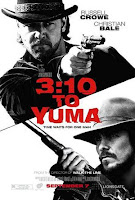 The most recent remake, and a damn good movie, is last year’s release of 3:10 to Yuma starring Russell Crowe and Christian Bale. Based on the short story by by Elmore Leonard and the 1957 film, James Mangold’s remake manages to maintain the intensity and integrity of the old Western, but still update the movie to a more jaded, tough 21st century audience. Although the story doesn’t quite make sense, the performances alone are enough to make this film great.
The most recent remake, and a damn good movie, is last year’s release of 3:10 to Yuma starring Russell Crowe and Christian Bale. Based on the short story by by Elmore Leonard and the 1957 film, James Mangold’s remake manages to maintain the intensity and integrity of the old Western, but still update the movie to a more jaded, tough 21st century audience. Although the story doesn’t quite make sense, the performances alone are enough to make this film great.
The Western Comedies:
The Western hasn’t always just been about weighty issues and themes–and the 1980’s and ’90s saw a rejuvenation of the genre…in comedy form!
The 1994 comedy Maverick, a film remake of the 1950s series, starring Mel Gibson, Jodie Foster, and James Garner is a wonderful take on the Western. With a less-than-upfront hero in Bret Maverick, a beautiful wily Annabelle Bransford, and a law Marshall that isn’t exactly a forthcoming straight shooter either, Maverick entertains and pokes fun at older Western conventions, while still playing by the rules.
The ’80s classic comedy Three Amigos also plays on Western conventions in a comedic remake of The Magnificent Seven.
The Science Fiction/Space Opera Western:
 Why not? Just as the American West and it’s unexplored nature as a new frontier was used as the perfect backdrop for these films, so too is outer space.
Why not? Just as the American West and it’s unexplored nature as a new frontier was used as the perfect backdrop for these films, so too is outer space.
Space Operas like George Lucas’ Star Wars series pay homage to the western–with bounty hunters like Boba Fett, gangsters like Jabba the Hut, and rogue pilots like Han Solo.
Gene Roddenberry’s Star Trek series (and subsequent movies in the ’80s) were also inspired by the Western–the opening sequence says it all:
Space… the Final Frontier. These are the voyages of the starship Enterprise. Its five-year mission: to explore strange new worlds, to seek out new life and new civilizations, to boldly go where no man has gone before…
Television show Firefly and subsequent movie Serenity, created by Joss Whedon, also follow the Space Western motif–not just figuratively with the renegade crew and rogue captain Mal, but in terms of costuming, weaponry, and actual planet settings. Robert Zemeckis‘ Back to the Future III takes Marty McFly back to the Old West in search of Doc Brown–and manages to poke some fun at Western elements…as Marty assumes the name Eastwood, dons the traditional serape, and partakes in a shootout a la Leone.
Another branch of the science fiction Western is with post-apocalyptic films, such as the Mad Max movies, or Kevin Costner’s adaptation of The Postman. ***Note: Costner misses again with The Postman. Please, for the love of all that is good READ THE BOOK and forget about the lamentable, deathly bore that is the movie.***
The Female Cowboy:
While the traditional Western focused on male gunslingers and characters, newer ventures have embraced the idea of the female cowboy. These attempts range from lamentable–with the laughable films Bad Girls and Bandidas–to superb.
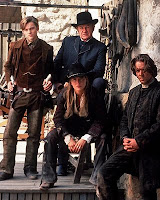
Leo, Gene, Sharon and Russell in The Quick and the Dead
Sam Raimi–yes, the same Raimi of Evil Dead and Spiderman fame (conversely of The Grudge 2 and Boogeyman infamy–what has happened to him!?)–directed a western in 1995, called The Quick and the Dead, starring Sharon Stone, Russell Crowe, Gene Hackman, and Leonardo DiCaprio. Sharon Stone plays Ellen “The Lady” (aka The Woman With No Name) in this film, hell bent on killing John Herod (played by Gene Hackman)–the twisted, sadistic man who rules the small western town.
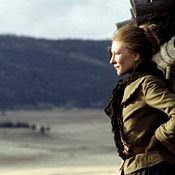 Ron Howard’s 2003 movie The Missing stars the brilliant Cate Blanchett as a mother who will stop at nothing to get her abducted daughter back from renegade Apache bandits who plan on selling her (along with other abducted females) across the Mexican border for money. In a bit of a twist on the traditional Western tale, this is a story where a mother goes after her children instead of the father figure (played by Aaron Eckhart), and features a rekindling between her and her estranged father (Tommy Lee Jones).
Ron Howard’s 2003 movie The Missing stars the brilliant Cate Blanchett as a mother who will stop at nothing to get her abducted daughter back from renegade Apache bandits who plan on selling her (along with other abducted females) across the Mexican border for money. In a bit of a twist on the traditional Western tale, this is a story where a mother goes after her children instead of the father figure (played by Aaron Eckhart), and features a rekindling between her and her estranged father (Tommy Lee Jones).
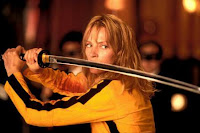 In a departure from the formal Western, Quentin Tarantino’s Kill Bill, with main character “The Bride” (an unnamed mercenary until Volume 2), also pays homage to the Western genre–in terms of music, scenery, and a new spin on The Man With No Name. Who is totally, unabashedly KICK ASS.
In a departure from the formal Western, Quentin Tarantino’s Kill Bill, with main character “The Bride” (an unnamed mercenary until Volume 2), also pays homage to the Western genre–in terms of music, scenery, and a new spin on The Man With No Name. Who is totally, unabashedly KICK ASS.
The New Westerns:
Finally, we come to the Contemporary Western. These new films, set in present day and time, are revisionist and throw old conventions straight out the window, or do not even take place in the “west” at all.
Die Hard, starring Bruce Willis, is my personal favorite film of all time. And it is a “western”. A lone gunman from the East travels to the west coast, and finds himself in a strange land, and thrown into danger. Enlisting (incompetent) outside aid, the lone marshal of justice, Mr. John McClaine takes down the entire bandit posse. Sure, the movie is set in 1988 Los Angeles in a hi-tech Nakatomi Plaza, but the Western rulebook is firmly in place.
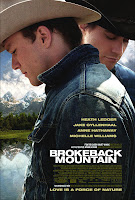 On a more serious note, the newer western Brokeback Mountain takes the traditional stereotyped image of the cowboy, and does away with any of the old rules and mores with the incredibly brave tale of romance between Ennis and Jack.
On a more serious note, the newer western Brokeback Mountain takes the traditional stereotyped image of the cowboy, and does away with any of the old rules and mores with the incredibly brave tale of romance between Ennis and Jack.
 Last year’s Coen brothers adaptation of Cormac McCarthy’s No Country for Old Men is the most recent movement of the contemporary Western, and probably the most bleak. The “good guys” or heroes truly are no more in this movement, and unjust, senseless death prevails.
Last year’s Coen brothers adaptation of Cormac McCarthy’s No Country for Old Men is the most recent movement of the contemporary Western, and probably the most bleak. The “good guys” or heroes truly are no more in this movement, and unjust, senseless death prevails.
So the Western, like any other genre has changed over time. While I don’t like ending this on the bleak, bitterness of No Country, I’ll leave you with a more lighthearted clip. My favorite scene from Three Amigos…starring the one and only El Guapo.
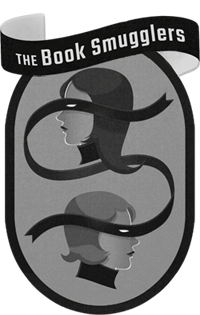
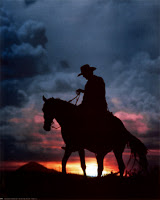

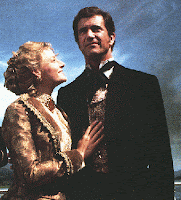
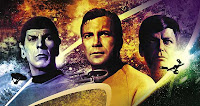



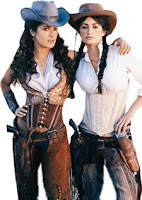
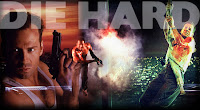








1 Comment
Mollie
April 4, 2008 at 9:47 amLove Tombstone, The Quick and the Dead, and Brokeback. Have 3:10 to Yuma to watch. Love me some Christian Bale. (Crowe doesn’t do much for me.)